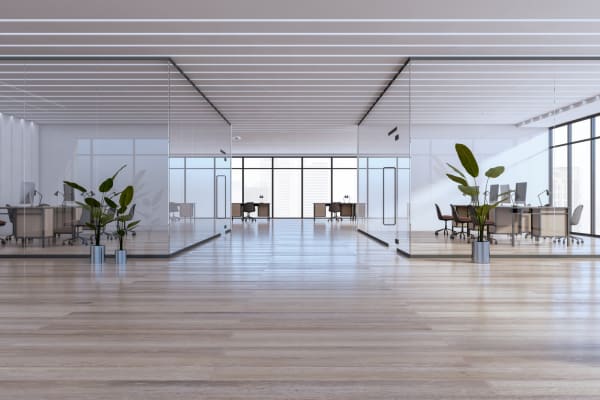1. Cost
Understanding the full spectrum of your investment is crucial. When considering cost, don’t just think about the purchase and installation. There are long-term factors like maintenance, repair, and even replacement costs. While hardwood floors might look like an aesthetic match made in heaven for your upscale boutique, these elegant options might not be the most practical or cost-effective over time.
When budgeting, keep in mind:
- The cost per square foot for materials and labor
- The expected lifespan of the flooring
- The upkeep and maintenance requirements
- Potential energy savings or tax incentives
Luxury Vinyl Plank (LVP), for instance, can closely mimic the look and feel of more expensive options at a fraction of the cost.
2. Maintenance Requirements
Maintenance is the silent cost of commercial flooring. It’s not just about cleaning; it’s about long-term durability.
Think about:
- The cost and frequency of professional cleaning
- Resistance to stains and wear
- Ease of repairs
Carpeting, for example, offers a luxurious feel and sound dampening but is one of the highest maintenance floors. Each option's unique properties should align with the time and money your business is willing to invest in upkeep.
3. Safety
In a commercial space, safety should always be a top priority. The right flooring can prevent slips and falls, and even save you from potential legal liabilities. Safety should be considered when the material is in place but also during its installation and maintenance.
Look for:
- Slip-resistant materials
- Smooth transitions between different types of flooring
- Any necessary additions like rugs or grip-tape
Carpet tiles, for instance, offer a balance between comfort and safety, with certain options designed to minimize slippage. Traction and grip should always be considered non-negotiables in any commercial flooring choice.
4. Aesthetics
Your flooring is a canvas for the rest of your interior design. It sets the mood and can complement—or clash—with your brand.
Consider:
- The business' image and environment
- The style and design of the flooring
- How it interacts with existing or planned decor
LVP, for example, comes in a variety of designs that mimic natural materials like wood or stone, offering a pleasing aesthetic with lower maintenance. This ties back into the cost as well, as a visually appealing space can increase customer satisfaction and revenue.
5. Sound Pollution
Noise pollution is a common problem in commercial spaces. The wrong flooring can lead to echoes, poor acoustics, and the spread of noise throughout your space.
Factor in:
- Acoustic properties of the flooring material
- Potential for underfloor soundproofing solutions
Carpeting and some rubber floors can offer significant noise reduction, making them perfect for areas where a quiet environment is essential, such as in offices or libraries. Identify the noise requirements for your space and choose a flooring that caters to them.
6. Comfort
Employee well-being and satisfaction are often reflected in the comfort of their work environment, which includes the flooring they walk on every day.
Decide on:
- Underfoot comfort
- Support for long-term standing or walking
- Climate and temperature management
Standing desks and ergonomic chairs are trendy, but the role of flooring in comfort is often overlooked. Materials like carpet and vinyl can provide extra cushioning, enhancing the comfort of the space.
Choosing commercial flooring is a significant investment that requires forethought and consideration. The experts at The Wholesale Flooring Company can help you navigate the myriad options to find the perfect flooring for your business. With showroom locations in North Myrtle Beach and Murrells Inlet, our team is ready to provide you with the guidance you need. Your satisfaction is our priority, and we’re excited to help you transform your commercial space.







